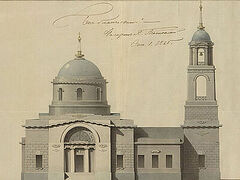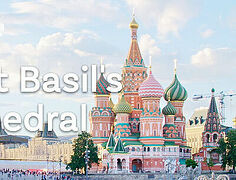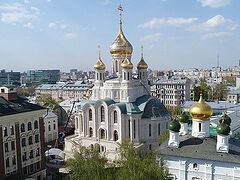What should be the main thing for an architect who designs and builds a church? Can a non-religious architect build a “right” church? And can modern architecture and art speak about Christ and be Christian? We talked with the art critic and practicing architect Andrei Yakhnin about these and other things.
 Notre-Dame du Haut. The famous chapel in Ronchamp.
Notre-Dame du Haut. The famous chapel in Ronchamp.
—Andrei, let us talk about modern church architecture.
—One could talk about it for hours.
—Yes, it’s a profound subject, as is the subject of modern art in general.
—The question is whether what is being built now is good or bad?
—Generally speaking, it’s so. But we can’t declare this so categorically. Time is reflected in architecture, which is “frozen music”, as the philosopher Friedrich Schelling (1775—1854) put it. And he who pays the piper calls the tune. If we draw a parallel with modern art, is there a feeling that we—contemplators and consumers of art—are being fooled and shown objects that they are trying to pass off as works of art?
—Indeed, we are. But this formulation is too simplified. Let’s say it more generally: The modern concept of art history doesn’t correspond to reality at all. In reality, the nature of this phenomenon is different from what modern popular art history tells us.
 The art critic Andrei Yakhnin. —Contemporary church architecture is far from canonical; it is even somewhat innovative. The eye first resists it but then gets used to it. The most important thing is that people come to new churches and pray in them. Is any church a house of God?
The art critic Andrei Yakhnin. —Contemporary church architecture is far from canonical; it is even somewhat innovative. The eye first resists it but then gets used to it. The most important thing is that people come to new churches and pray in them. Is any church a house of God?
—There are several absolutely different reasons for this phenomenon of the isolation of modern church architecture from canons and traditions. There has been a certain trend in world church architecture since Vatican II. The main point is that modern churches are designed and built according to principles that are completely different from the traditional. As a rule, the architects who design them aren’t church people. These are secular architects, adherents of very different faiths, hired by clients. In some European countries, this is a kind of government program, in which historical churches are closed, converted to other purposes and replaced by modern church buildings where the logic of construction materials prevails over the logic of the Church. This trend has been known to everybody for a long time. Unfortunately, we are catching up with Europe and fitting into this plan of destruction. We are currently on the same track, and that’s a problem. This concerns culture, church architecture and everything else. The secularization of church architecture is a trend that is gaining momentum worldwide.
—We have joined this trend and are moving by inertia?
—That’s the first factor. The second is that a huge number of secular architects who live in a different realm are building churches now. They simply “express themselves” this way, without understanding, feeling or knowing what a church is like. Their knowledge in this sphere boils down to two or three lectures at institute. But the main problem is that they are not church people, and sometimes they even have an anti-Church attitude. These people receive an order and design a church as they can, as they imagine it should be. It is extremely strange. Imagine the absurdity of a situation if an airport were designed by someone who has never been to an airport, has never flown in an airplane, and has no idea what it is like. But they believe they can design a church after reading some booklet and picking up a smattering of knowledge!
When designing a church, it is not enough to know the history of church architecture. It is necessary to feel the liturgical logic.
In the Catholic world, this trend in modern church architecture has found government support. This is a fundamentally different approach to liturgical space. Vatican II decreed that any culture, including modern secular culture, can be introduced into the sanctuary and become part of the liturgical space.
This led not only to a radical breakdown in traditional church space, but ultimately to serious transformations in spiritual life within the Catholic Church.
I think it’s impossible to stop it. We are moving in the logic of the process which corresponds to the Christian understanding of history. We should take into consideration that the whole world is not moving upward, but downward—iniquity is increasing.
—Realizing that iniquity is increasing, can we oppose this and not swim with the tide?
—We definitely should oppose this, while realizing that every day we are nearing the end of the world and the Second Coming of Christ. The approach of the Last Judgment is accompanied not by an increase, but a decrease in spirituality. This should be understood and resisted by each of us on a personal level. It is pointless to resist this process globally.
—You’re drawing a pessimistic picture: the “chariot” of spiritual life is going downhill…
—I see this otherwise. The “chariot” isn’t going downhill—what we see is the natural course of history in its Christian understanding. We all need to understand where we are moving. We’re heading for the natural end of history, when there will be a new heaven and a new earth. I wish it would happen sooner! But when it will take place—now or in 1,000 years—it isn’t given us to know. So the general process is downwards. This trend is evident, and it’s clear to us; but it doesn’t mean that humanity is to move obediently in this direction, its head lowered. It should be realized and resisted whenever possible—this is our task. We should understand that we won’t change anything globally. But in our own environment, whether it’s small or large, we can change the trend—even though globally everything will keep moving in the same direction.
—Would you agree that in general the life of a Christian begins with church? The church he attends…
—Do you mean a church building?
—Yes, a church building.
—Which building we go to—of course, it matters. There was a famous story when Le Corbusier designed the Ronchamp chapel.
—I read that Notre-Dame du Haut (“Our Lady of the Heights”) is called from an artistic point of view the most significant religious building of the twentieth century, and it belongs to the modernist trend of new Expressionism, developed and proclaimed by Le Corbusier.
—Exactly. A Christian chapel had existed on that site since the thirteenth century. It had been a sort of holy place. The chapel was destroyed by time and wars, and in the 1950s the new building of Le Corbusier appeared on its site. This structure is mentioned in all textbooks and is regarded as a masterpiece of contemporary architecture. But nobody prays in it now—it stands empty.
True, which church you attend is important. It’s a key point. I don’t want to say that modern architecture is unsightly, while traditional church architecture is attractive. I’m speaking about very different categories. For example, a painting may be very beautiful, but its function is different from that of an icon. An icon has different characteristics. What is beautiful in a painting and what art lovers admire shouldn’t be admired in an icon. I’ll repeat myself: Its purpose is different. This also applies to a church. The point is not whether it’s good or bad, but that modern architecture is simply not a church. At the same time, it may well be an interesting, unusual building according to its own laws. Unfortunately, we see examples of extremely strange (if not worse) creative work of modern church architects ever more frequently.
—Parishioners will get used to any church and create a prayerful atmosphere in it, right?
—People get used to everything. Have you noticed this?
—Sure.
—Church life won’t disappear because of this. People will come to such buildings too. Though, in my opinion, this indicates that church life is fading away.
New churches will root themselves into our lives. But this evokes more sad feelings than joyful ones. Many things are becoming part of our lives, but the result is unclear.
Modern people are indiscriminate. Contemporary culture is designed to decompose human beings into molecules and not compose them.
A person who was brought up in modern culture has no backbone. His consciousness, spiritual world, and psyche are divided. It’s difficult to put together a picture of the world. It’s not because the world is now tolerant to everything and has no traditions. They have been lost. We live in a time when modern church architecture, in my view, presents a sad picture—but it’s inseparable from other aspects of our life. The absence of backbone has not only to do with our recent past, but also with the fact that in the world in which we live all information is designed to fragment perception into many small meanings. So it’s difficult for modern people to exist.
The intensity of church life is melting before our eyes. We have observed this, it’s no secret. Spiritual effort is obviously on the wane.
—Why do you think this has happened?
—If we think globally, at some point Christian history and civilization was at its peak, but then it was blurred and secularized in a natural way. We can divide the history of the culture of Christian civilization into three major stages.
Stage 1 was soteriological. It was characterized by the idea of salvation and righteous life in Christ. It was a purely religious, Church culture—a kind of pinnacle of the development of Christian culture.
Stage 2 coincided with the development of humanistic ideas and was called the Renaissance. Though formally and outwardly it was still the Church culture, it was no longer such by its spiritual nature. Now at the center of civilization was the idea of physical harmony, the benefit of the State etc. and not the ideal of pious life in Christ. That period marked the birth of a secular, non-Church culture, which over time moved further and further away from its Christian origins.
And, lastly, stage 3 can be characterized as demonic. It was the radical shift of cultures in the early twentieth century. In the center of this culture is man who strives for absolute and unlimited freedom—a man possessed with demons. This understanding of the history of culture brings us closer to understanding the processes that are taking place in our days.
—What do you think of the following picture? A person enters church, bows low in front of icons, observes fasts and participates in the sacraments; but beyond the church threshold he is a different person—he casts prudence to the winds. Maybe this is because the church is without grace and was built by “wrong” architects?
—I don’t have such profound spiritual experience and authority as to answer such difficult questions. I myself have more questions than answers in this sphere. And I try to pose them to people who stand higher on the spiritual ladder. But I guess that the liturgical space and its filling are of paramount importance for modern people’s spiritual life. True, we have the experience of the saints who struggled in caves and deserts, secretly served God in labor camps, lacking wine for the Eucharist, to say nothing of icons and churches. But, alas, we are not like them—this we have to admit it. We are weak, cowardly and lacking faith. That’s why the liturgical space, church and icons should help us collect our crumbled spiritual insides, and not the other way around.
—Is modern culture absolutely hostile to Christian life?
—It’s part of an interesting question I am studying now. Let’s look at things through the lens of art, since we began with this. There is a general trend of modern art. There is no doubt that it’s anti-Christian—not just non-religious, but anti-Christian. And it should be said that contemporary art, in addition to its main content, has a certain form, formula and language, which is a means of modern communication. Outside this language, modern man often can’t exist. And nothing can be done about it, it can’t be resisted.
Some of my friends who pursued contemporary art have come to the Church. They have been trying to speak about Christ in the language of modern culture. There aren’t many such people and they are outside the mainstream. Such people can be found in Europe as well: these are Christian artists who exist (or struggle to exist) within the scope of modern art. That’s incredibly hard as they go against the stream and are to some extent on the margins of society and art. They have contact with each other, they have their own forums and exhibitions. I know about a project in Malta, which is an exhibition of contemporary Christian artists.
—Are you going to take part?
—As an old friend he suggested that I think up something on this subject. I have done this, but I don’t know if it fits into the concept. I think it’s an example when you can try and talk about Christianity and Christ within mainstream culture without going into the cultural catacombs or succumbing to the main trend.
—Getting back to the topic of our conversation—how can we raise the level of modern church architecture?
—The trouble is that today indeed many churches are being built, so there’s a shortage of church architects. Indeed, where will we get so many actively religious architects? These should not just be graduates of the Moscow Architectural Institute—they should live in the Church and participate in the liturgical life. To live the life of the Church is a necessary, though not sufficient, requirement for a church architect. Someone can’t go and design churches right after graduating from the Department of Church Architecture if he has nothing to do with the Church. That’s nonsense. There was such experience in the late nineteenth and the early twentieth centuries—churches were designed and painted by members of the Academy of Arts, most of whom didn’t belong to Orthodox tradition. We know what that led to. In my opinion, there is only one path. And it doesn’t contradict the laws of architecture, which speak of the need to prioritize the function of the future building when designing it. And the church’s function is the Liturgy. It is the Liturgy (not the author’s self-expression, or the sponsors’ ambitions, or the city authorities’ tastes) that should be put at the forefront in its spiritual, historical and theological fullness.





